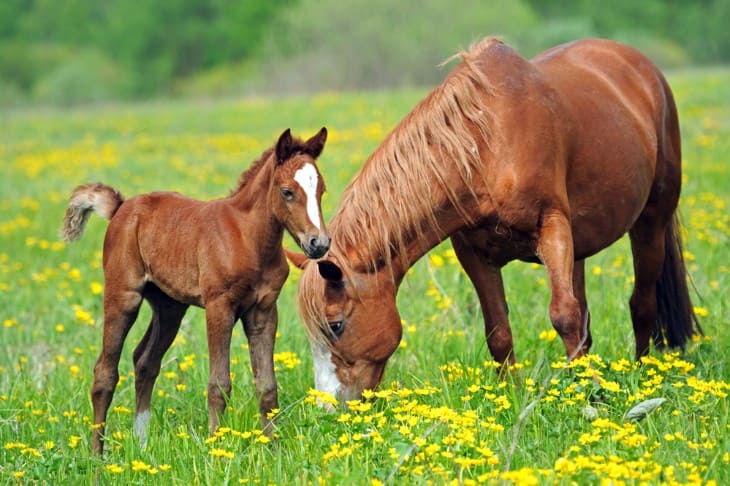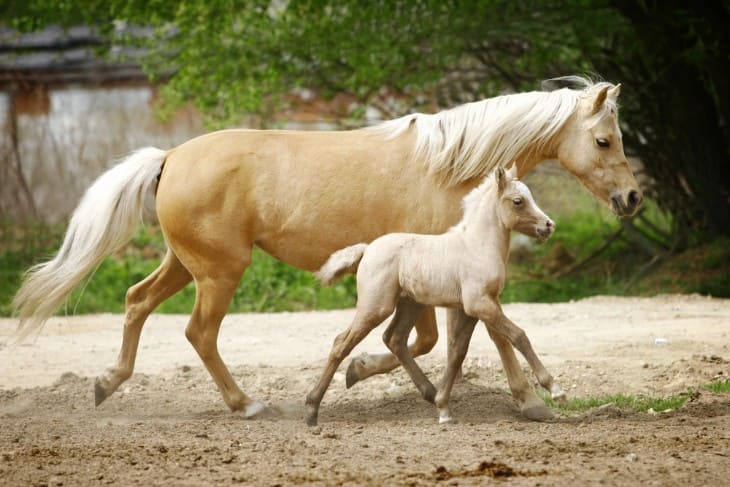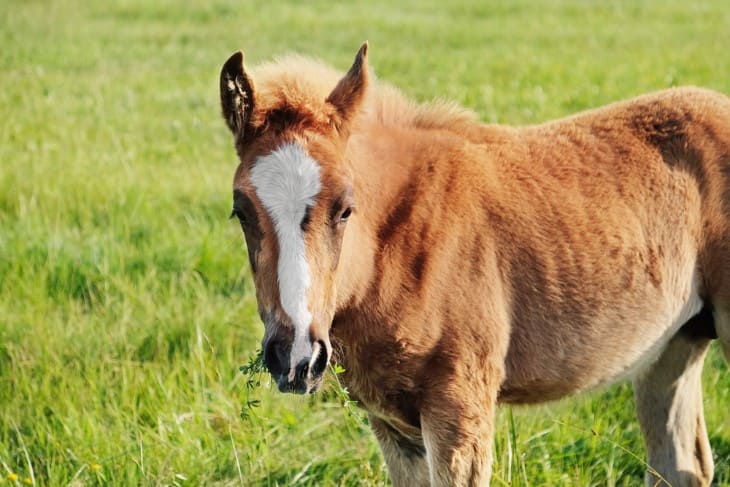The planet of horse racing is filled with thrills and anticipation, not only about the races themselves but also concerning the possible stars that will unfold every year. These stars usually begin their journey as foals—baby horses representing the future of racing. This article will delve into what a foal is, its early life, and its significance in horse racing.
What exactly is a Foal?
A foal refers to a young horse under one year old. The term is used for both male and female horses during their first year. Knowing this helps anyone interested in horses for casual riding, care, or even competitive purposes such as racing.
These young equines are called foals from birth until they turn one year old. After that, their names change according to gender, with males being called colts while females are called fillies until adulthood. These terms are important because they enable vets, trainers, and breeders to communicate clearly about the different kinds of horses they might be dealing with.
Knowledge about various stages in the early life of a foal enables the provision of appropriate care and training, which may shape its future health and performance during races or any other activity involving horses. They go through rapid growth phases; hence, each stage within their first year becomes critical towards development; where at this point, bonding takes place between them & their mother, besides starting to interact with other animals within the environment, i.e. (other) horses alongside humans.
It can be said that these creatures represent the earliest phase(s) among living things belonging to the Equidae family, commonly known as ‘horse’. Such periods are characterised by fast rates of growth accompanied by quick learning processes, thus laying the foundation for subsequent years’ development, whether joining the competitive world through racing or becoming a beloved riding/show pony, whereby everything starts when still a baby animal referred to as “foal”. Therefore, having knowledge plus understanding of this initial phase should not be underrated by anyone looking after them.
First Hours of Life
A few hours after birth are very important for a foal. During this time, a horse's health and development can be greatly influenced. Immediately following its birth, the newborn foal tends to be quite active; hence, its first major task entails standing up and starting to suckle milk from the dam, which usually takes place within an hour or two. This ability to stand up fast and begin nursing indicates good health as well as strength on the part of such an animal.
Colostrum, the mother’s first milk, contains many nutrients and antibodies necessary for protection against diseases during foals' early months of life. Therefore, these animals' quick acquisition of enough colostrum strengthens their immune systems.
During these initial hours, the mare (female parent) and her foal(s) start bonding. The significance lies in making a young one feel safe apart from learning certain things through observation & imitation, helping it grow into a healthy adult horse that can fend for itself later on without depending too much on humans or any other external assistance. For instance, through direct contact with other members within its species, especially those older than themselves, they acquire valuable knowledge about where to find food and various social skills required when dealing with peers.
Veterinarians also examine newborns during the first few hours, carrying out different checks, such as testing reflexes, to ensure everything is okay with both mother and child.
The initial hours of a foal’s life are eventful and important, determining its future. The main goal at the start of a foal's healthy life is to make sure that it stands, suckles well, and attaches to its dam or mother. These first few moments are not only survival but also building blocks for vibrant years ahead.

Development Landmarks
A foal's first milestone is standing up and walking. This can happen within a few hours after birth, which is essential because it shows that the baby horse has the power and control necessary for basic movement. Standing up and walking also allows them to feed off their mother’s milk, which provides essential early nutrition.
- First Teeth: The foal will begin to get its first teeth around two or three weeks old. This step readies them for weaning and starting on solids. Healthy teeth are crucial for proper eating habits and growth in foals.
- Weaning: Weaning occurs when a young horse transitions from drinking milk produced by his or her dam (mother) to eating solid food like hay, grasses, or grains such as oats. It typically occurs between 4 and 6 months of age but can vary depending on various factors such as health conditions, etc. Weaned babies still need special care because their digestive systems are not yet fully developed.
- Social Skills: Developing social skills is another significant milestone. Foals start interacting with other horses and learn to behave in a herd setting. This phase helps build mental soundness in them while teaching them what is right or wrong behaviorally, too! Moreover, it prepares them well mentally and physically for future training programs they may undergo later on in life. They are also exposed to different environments where people live together harmoniously.
Each of these development milestones is crucial in a baby horse's early life; they promote physical growth and healthy living with others. Moreover, timely achievement of these goals ensures general wellness throughout the animal’s entire lifetime, whether engaged in racing activities or any other equestrian sport.
Nutrition During Weaning
When referring to weaning indicates moving away from breastfeeding towards consuming solid meals. Typically beginning at four to six months old, this process must be gradual so that the foals can adapt themselves both physically and emotionally. During this period, the amount of hay, grass, and specially formulated foal feed should be increased.
Proper nutrition during and after weaning is essential for the baby horse’s growth. A new diet must contain all necessary nutrients supporting fast development in foals, such as proteins for muscle construction or calcium, which is required for strong bone formation. In addition, vitamins and minerals must be adequate to ensure the complete wellness of animals.
It is also crucial to closely monitor their health condition throughout this stage since changes in diet may provoke digestive problems if not properly managed. Therefore, observing them will enable one to detect any signs of discomfort or sickness earlier, thereby facilitating prompt intervention.
Smooth transitioning through weaning sets a solid foundation towards healthy adulthood; this reduces anxiety levels among young equines, besides promoting the formation of eating habits that contribute towards becoming robust horses. This phase does not just involve changing what they eat but instead preparing them physically & mentally, for good health throughout their lives, which becomes more critical, especially for those intended to participate in racecourses or other competitive disciplines.
Training Foals
When training young foals, gentle but essential basic handling is used. This first step acquaints the foal with human contact and starts teaching them simple commands. At such an early age, training consists of getting the foal accustomed to being touched all over its body, having its hooves picked up, and being led gently by a halter. Doing this will help prepare them for more formal teaching later on in their lives.
The groundwork is everything in the initial training because whatever comes after depends on it. More complicated tasks like saddling or riding can be taught to horses trained as foals for races. The only thing required here is consistency alongside patience since they have a limited concentration span; hence, each session must take a short time while dwelling on positivity by rewarding good behaviour.
It is necessary to ensure safety during these early lessons, too. Both trainers and foals should be kept within safe, enclosed spaces where the latter can feel secure without getting injured. Such environments allow exploration and learning without unnecessary stress or fear.
Trust-building and imparting elementary skills form part of training young foals. This initial education guarantees good manners and self-assuredness among horses as they grow up.Whether bound for race tracks or leading less active lives, the foundation for success and well-being in the future lies in what is done during their days as little ones on earth.
Genetics and Racing
- Inheritance of Traits: A racehorse’s potential for success is determined by genetics. The qualities largely inherited by a successful racehorse include speed, stamina, and temperament. Breeders choose the sire (father) and dam (mother) carefully so that their children will inherit the best traits of each parent; this ensures physical and psychological excellence in horses bred to run fast.
- Breeding for Performance: It’s not just about putting two horses together during breeding season – it’s about matching up animals with complementary traits to produce offspring who have higher chances of becoming champions one day. For example, this might mean selecting a stallion known for its lightning quickness with a mare famous for her endurance; such an arrangement would be expected to yield foals inheriting both attributes. These decisions are based on generations' worth of records involving what works and doesn’t work within different families where racing has been pursued consistently over time.
- Genetic Diversity & Health: While targeting specific features through breeding is significant, genetic variety should also be maintained. This helps lower the risks associated with diseases due to too close blood relationships between mating partners, among other factors. A healthy horse performs better and thus stays longer in racing; breeders also strive towards making their babies strong but resistant by considering good genes’ health.
Genetics is a powerful tool when it comes to shaping future racehorses; allowing breeders to plan and predict the abilities of their stock while demanding trade-offs between performance, robustness against ill-health or disease emergence vulnerability vis-à-vis current welfare levels, amongst others, shows how much more intricate this can get! Indeed, these words alone -‘role’ and‘ genetics’- imply science blended with strategy at work within racing towards creating tomorrow’s champions.

Health Care and Management
For young horses to grow into powerful athletes, they need proper medical care at all stages of life, starting from birth. Regular veterinary check-ups form an integral part of foals’ healthcare; these examinations enable early detection and intervention of any health problem which could have long-term effects on an individual’s overall well-being. Other things checked by vets during this period include height, weight, and heart and lung sounds, among others.
Vaccination is another crucial element in caring for young horses since, just like people, equines can contract various diseases, some of which may be life-threatening if not prevented through immunisation. Timing vaccinations appropriately helps build immunity against common ailments during the early years; moreover, deworming must be done regularly alongside such injections so that parasites are kept at bay, promoting good health and steady growth rates among foals.
Proper grooming, too, falls under management practices aimed at ensuring soundness status amongst youngsters. Routine cleaning keeps them neat while fostering stronger bonds between human beings responsible for their welfare and these animals themselves; besides, it offers an opportunity for early recognition of skin problems and wounds that might deteriorate further when left untreated.
However, health can be looked at by treating diseases and preventing them; therefore, a conducive environment should always be provided for young people’s upbringing right into adulthood. This entails having clean stables where they sleep or rest and well-ventilated areas where fresh air can circulate freely without posing risks such as respiratory infections due to dampness or dust accumulation; similarly, safe paddocks need to be established where they get enough exercise time without getting hurt easily.
Looking after the health and welfare of foals means much more than just reacting when things go wrong. It’s about preventing issues from arising in the first place through proactive measures and regular attention that allow the young horse to grow into a healthy, vigorous adult. This holistic approach to healthcare is vital for every equine, particularly those destined for racing at a high level.
Socialisation and Behaviour
Socialisation is key during early life stages for any animal—not only does it help shape their behaviour as they grow up, but it also influences how well they adapt to new environments or situations later on down the line. When introduced to other horses (and humans) at an early age, foals learn valuable social skills that will stand them in good stead throughout their lives. These skills enable effective communication with peers, facilitate play among siblings or stablemates, and establish hierarchy within a group.
A well-socialised individual tends to be more self-assured and tractable – two qualities much prized in any horse! Such confidence comes into its own when faced with novel or potentially threatening stimuli because less fear is involved; consequently, these animals experience lower stress levels under such circumstances, too. Thus, whether it’s meeting strange people, being taken to new places, or coping with noise, crowds, etc., around racecourses – well-socialised foals are generally calmer and quicker to adjust.
The training process can also contribute towards this end by furthering a foal’s socialisation. For example, during handling sessions, they become used to following human leadership while still being treated respectfully/non-threatening; likewise, positive reinforcement methods adopted here help reinforce desirable attitudes towards contact with people later on. In addition, different types/environments should form part of their education, e.g., some exposure beyond usual stabling/turnout areas so that, as adults, these animals are more rounded individuals capable of dealing successfully with variety throughout life.
Effective socialisation isn’t only concerned with producing sociable individuals. Rather, it’s about establishing foundations where trust and confidence can flourish—qualities that will serve them well in all spheres of existence. Thus, whether bred for speed, pleasure riding, or simply companionship, a horse that has been properly introduced to the world around it tends not only to be happier but healthier, too.
Takeaway
Foals are more than just young horses; they’re potential racecourse heroes waiting to happen. Everything from genetics through early training should aim to maximise their chances of success on the track. By understanding what makes these animals tick and helping nurture them along the way, breeders/trainers/owners can assist such individuals in achieving stardom at some point later in life.
Every foal has the ability to become a legend within racing circles—this belief underpins much planning throughout its initial months/years prior to competing. The industry knows that somewhere out there amongst all those newborns lies tomorrow’s superstar(s), so each one is treated accordingly from day one!






